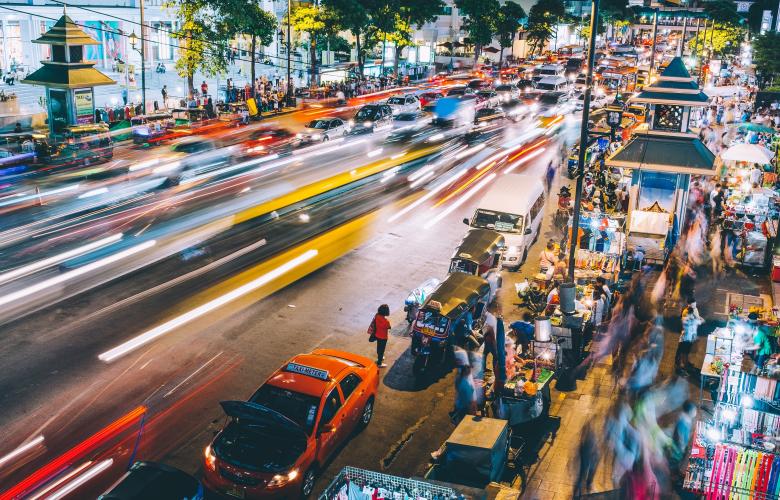The rush for rail in Southeast Asia’s fastest growing cities
Contact
The rush for rail in Southeast Asia’s fastest growing cities
"As the region continues to grow, modern and reliable public infrastructure has never been more of a priority." JLL
Heavy traffic has become a way of life in many of Southeast Asia’s urban areas, causing major issues not just for locals on their daily commutes but also long-term damage to their health and the environment.
And it’s going to get worse as the population continues to rise fast. By 2030, the number of inhabitants in the region is expected to increase by more than 100 million to reach over 720 million people, according to research by ASEAN Up.
With many local authorities highlighting the role of inadequate transport infrastructure in exacerbating the problems of high density living, a number of cities in the region are turning to a metro system as a solution to the growing pressure.
“Every city needs to plan for its future especially with rising populations,” says Veena Loh, JLL’s Head of Research in Malaysia. Take for example the country’s greater metropolitan area of Klang Valley, which will see its population grow from over seven million currently to more than 10 million by 2020. By 2030, it could hold almost half of Malaysia’s estimated populated of 35 million people.
A 2014 study by Nielsen shows that car ownership in Malaysia stood at 93 percent of the country – the third highest in the world. Such a high dependency has prompted Kuala Lumpur to roll out a number of new rail systems such as the 51km-long Mass Rapid Transport (MRT) line stretching from Sungai-Buloh to Kajang under a plan to transform the city’s public transport system by 2030.
“With the ever-increasing road congestion, MRT will enable the city to move a large population rapidly and efficiently, thereby reducing its carbon footprint,” says Loh.
A challenge for Asia’s megacities
Ho Chi Minh City and Hanoi in Vietnam, Jakarta in Indonesia, and Manila in the Philippines are also reaching a tipping point. In Jakarta, which has the dubious honor of having the worst traffic in the world, and Manila, aging commuter trains have long been operating beyond capacity. Meanwhile, Ho Chi Minh City and Hanoi previously lacked city rail transportation altogether.
Fortunately, times are now changing. Fears over gridlock and the need to open up new areas for development have sparked their respective governments into action, with potentially revolutionary development underway across all four cities. Once operational, the lines are expected to open up new parts of each city for real estate expansion.
In Ho Chi Minh City, the metro is expected to cover 70 percent of the city and will change the real estate landscape in terms of supply and demand, says JLL’s Head of Research in Vietnam, Trang Le.
“Owing to uneven infrastructure development, most residential and commercial projects here typically have been concentrated to central areas or smaller fringe developments,” she says. “By improving the infrastructure and accessibility, the Vietnamese authorities hope to encourage more developers to invest in large-scale real estate projects across the city.”
A similar scenario is playing out in Hanoi, Jakarta, Kuala Lumpur and Manila, which all hope that new or upgrade rail lines will spark investor appetite.
Several developers including SM Prime Holdings, Ayala Land, Filinvest Land and Century Properties, for example, are already eyeing up areas along Manila’s new 22.8km-long MRT7 route from San Jose del Monte station to Quezon City, says JLL’s head of research in the Philippines, Claro Cordero. “With the established players participating in these projects, new and more planned communities are being developed thereby bringing up property values,” he says.
In Jakarta, JLL’s Head of Research in Indonesia, James Taylor, says shorter and guaranteed travel times have the ability to open up previously undesirable locations outside of the city for its inhabitants.
Already, the Indonesian’s capital’s spanking new airport train was officially launched at the start of January 2018 to much fanfare and the transport minister declared that three more airport rail links would be opened this year.
Growing pains
Such major changes have not been without its challenges as these metro projects have spluttered along for years, even decades. For instance, both the Hanoi and Ho Chi Minh City schemes, which had been mooted a decade ago, were plagued by an array of funding problems.
In the Philippines, meanwhile, Japan has stepped in to help fund Manila’s metro aspirations through a Public-Private Partnership.
Operational sticking points may also lie ahead for a number of the schemes. Engineering and design difficulties could surface in Manila, with the city being subject to perennial flooding – an issue for flood-prone Ho Chi Minh City to consider as well.
In Kuala Lumpur, old habits die hard. Many residents still prefer to use their car for the journey to and from the station and a lack of sufficient car parking at existing light rail transit (LRT) stops has not only prevented potential users from switching to LRT rides but it’s also created a negative perception around the use of rail, observes Loh.
Yet for millions of people across Southeast Asia’s big cities, the new metros have the potential to herald a new era in terms of lower pollution, better connectivity, higher quality of life and stronger economic development. And as the region continues to grow, modern and reliable public infrastructure has never been more of a priority.
Source: JLL
Similar to this:
https://www.retalkasia.com/blog/marciano-birjmohun-property-specialist-thailand/bangkok-ready-transit-orientated-developmentIs Bangkok ready for transit orientated development?
ASEAN infrastructure investment set to increase region’s growth






